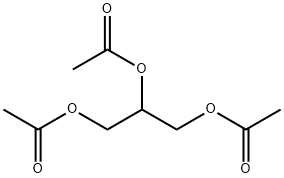Triacetin: Versatile Acetylated Glyceryl Ester in Modern Chemistry
Introduction
Triacetin, also known scientifically as glyceryl triacetate, is a clear, colorless, and odorless liquid that plays a pivotal role in various chemical and industrial applications. Its chemical formula, C_9H_14O_6, reflects a structure where three acetate groups are bonded to a glycerol backbone, making it a triglyceride that is both simple and versatile. This article provides an in-depth look into the synthesis, composition, applications, and storage of triacetin, aimed at professionals in the chemical industry seeking comprehensive knowledge about this important compound.

Figure 1 Characteristics of Triacetin
Synthesis of Triacetin
The synthesis of triacetin primarily involves the esterification of glycerol with acetic acid. This reaction is typically catalyzed by acidic or basic catalysts and can be conducted under reflux to ensure complete conversion. The process may vary slightly depending on the desired purity and yield, with industrial synthesis often scaling up this reaction under controlled conditions. Advances in catalytic systems and process engineering have enabled more efficient and environmentally friendly production methods, which are crucial in meeting the growing demand for triacetin in various sectors.
Main Components and Chemical Properties
Triacetin is a triester composed of glycerol and acetic acid. The ester bonds in triacetin give it unique properties such as a high boiling point, low volatility, and excellent solubility in common organic solvents. These properties make triacetin not only effective as a plasticizer but also valuable in applications requiring a stable, non-volatile solvent. Furthermore, its biodegradability and low toxicity profile enhance its appeal in applications that prioritize environmental safety and human health.
Uses of Triacetin
Triacetin's applications are diverse, reflecting its utility in various industrial and chemical processes. It is extensively used as a plasticizer in cellulose-based plastics, providing flexibility and durability to products such as film coatings and tool handles. In the pharmaceutical industry, triacetin serves as a solvent and excipient, aiding in the formulation of capsules and tablets by enhancing the dissolution of active ingredients and improving their bioavailability. Its fungicidal properties are leveraged in agricultural applications, particularly in fungicides and pesticides, where it acts as an effective carrier that helps in the controlled release of active agents. Additionally, triacetin is employed as a food additive, acting as a flavor carrier and food contact material, used to enhance flavors in baked goods and confectioneries. Its role in the production of smokeless gunpowder highlights its importance in defense applications, where it is valued for its stabilizing and plasticizing properties, contributing to the consistency and performance of propellants.
Storage Methods for Triacetin
Proper storage of triacetin is essential to maintain its chemical integrity and functional qualities. It should be stored in a cool, dry place away from direct sunlight and heat sources, which can promote hydrolysis and degradation. Containers of triacetin must be tightly sealed to prevent contamination and minimize exposure to moisture. In industrial settings, stainless steel or aluminum tanks are recommended for bulk storage, equipped with temperature control systems to ensure stability during storage. Regular monitoring and maintenance of storage conditions are crucial to prevent quality degradation over time.
Conclusion
Triacetin continues to be a compound of great importance in the chemical industry due to its versatility, safety, and efficacy in various applications. Ongoing research and development efforts are expected to further expand its applications and improve its production processes. For chemical professionals, understanding the synthesis, properties, uses, and proper storage of triacetin is essential for optimizing its use and leveraging its benefits across different industries. As we advance, triacetin will undoubtedly remain a key player in the formulation of more sustainable and efficient chemical solutions.
This overview of triacetin not only informs but also underscores the significance of this compound in modern chemistry and industry. By ensuring the efficient use and careful management of triacetin, the chemical sector can continue to innovate and thrive in an increasingly complex and demanding global market.
![Article illustration]() References
References
[1]Casas A, Ruiz J R, Ramos M J, et al. Effects of triacetin on biodiesel quality[J]. Energy & Fuels, 2010, 24(8): 4481-4489.
[2]Laino T, Tuma C, Moor P, et al. Mechanisms of propylene glycol and triacetin pyrolysis[J]. The journal of physical chemistry A, 2012, 116(18): 4602-4609.
);You may like
Related articles And Qustion
See also
Lastest Price from Triacetin manufacturers

US $10.00/PCS2024-05-28
- CAS:
- 102-76-1
- Min. Order:
- 1KG
- Purity:
- 99%
- Supply Ability:
- 10 mt
US $100.00/KG2024-05-28
- CAS:
- 102-76-1
- Min. Order:
- 1KG
- Purity:
- 99%min
- Supply Ability:
- 200TON


